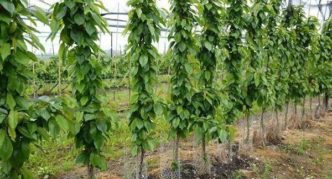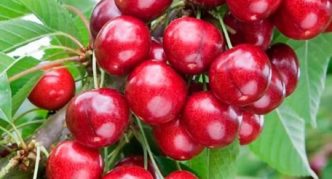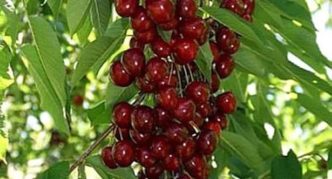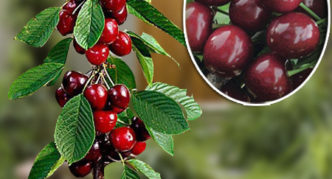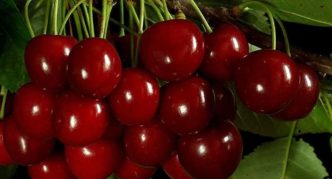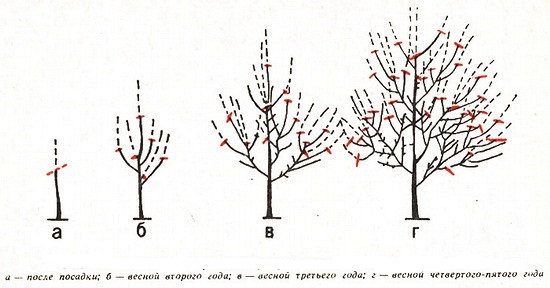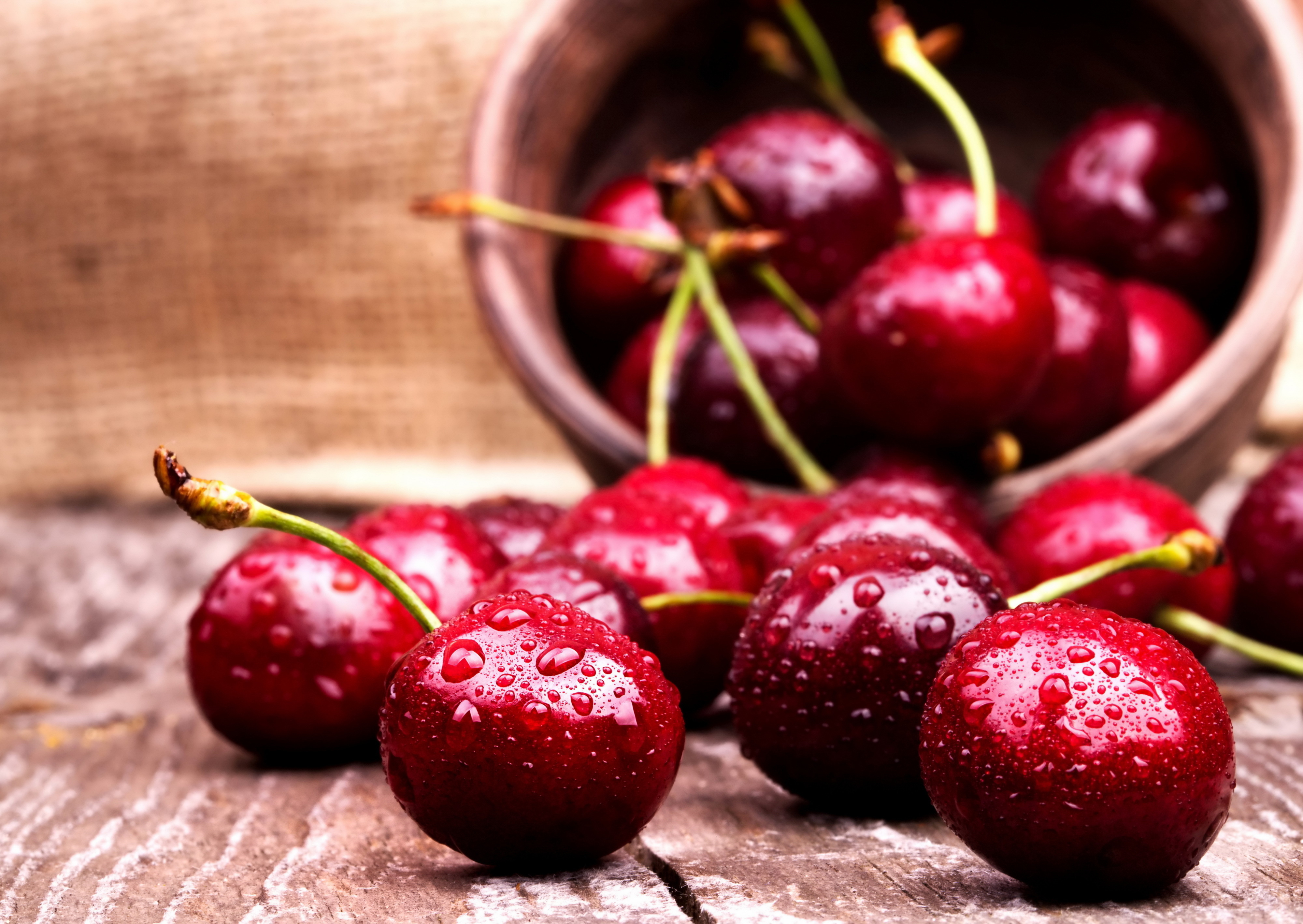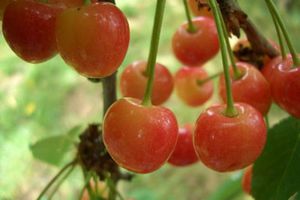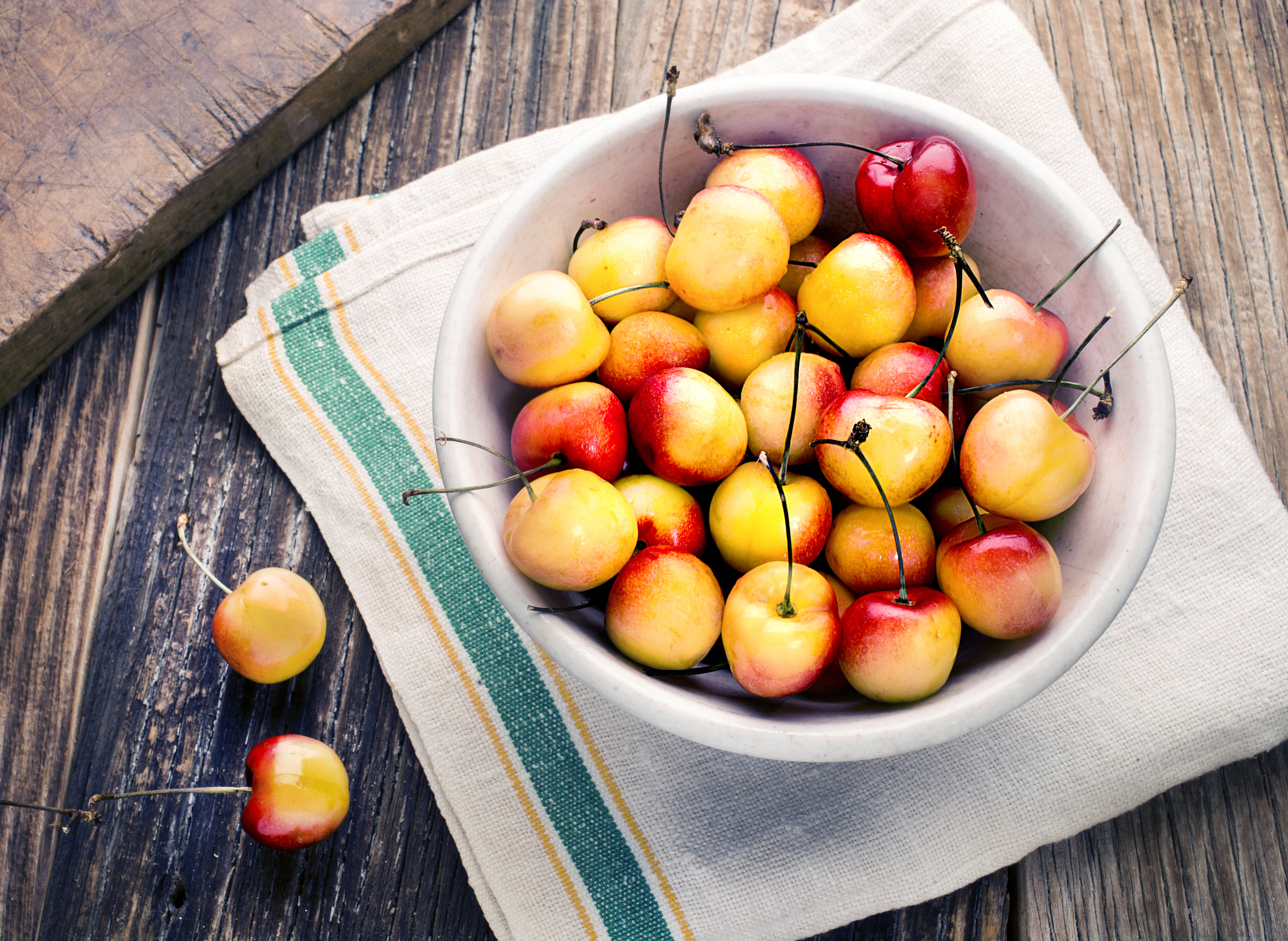A rare summer resident of central Russia does not try to plant at least one cherry tree on his site, even knowing that this culture is very whimsical and capricious. When it is possible to harvest a crop, it is said about the skill of the owner, and if the berries have not been waited for, then they usually appeal to the fact that the role of cherries was reduced solely to pollination of cherries growing nearby.
Content
Cherry varieties for central Russia
The concept of the middle zone of Russia is conditional and does not coincide with the division into regions adopted in the State Register of the Russian Federation. It covers the North-West region (with the exception of the Kaliningrad region), the Central and Central chernozem regions, as well as almost the entire Volga-Vyatka and Middle Volga regions. The climate in such a territory is heterogeneous, but in general it is characterized by warm, rather humid weather in summer and moderately cold snowy winters. Average temperature readings range from -12aboutFrom winter to +21aboutHappy summer.
The first scientific attempts to adapt southern culture to new conditions were made by I.V. Michurin. The bred cherry became the foundation for further breeding work to create new cold-resistant varieties. The variety of the obtained types of sweet cherries makes it possible to classify them by a variety of characteristics, primarily by the color of the fruit.
Yellow-fruited cherry varieties
The cherry fruits are colored red, yellow, pink and orange. Sweet cherry with yellow berries is not as picky about climatic conditions as its relatives, therefore it is more adapted to grow and bear fruit in the climatic conditions of the middle zone, where severe winters are frequent.
Drogana yellow
Drogana yellow is an old variety with large amber fruits. Their average weight is about 6-7 g, some reach 8 g. The berries taste sweet, dessert, but they are poorly transported.
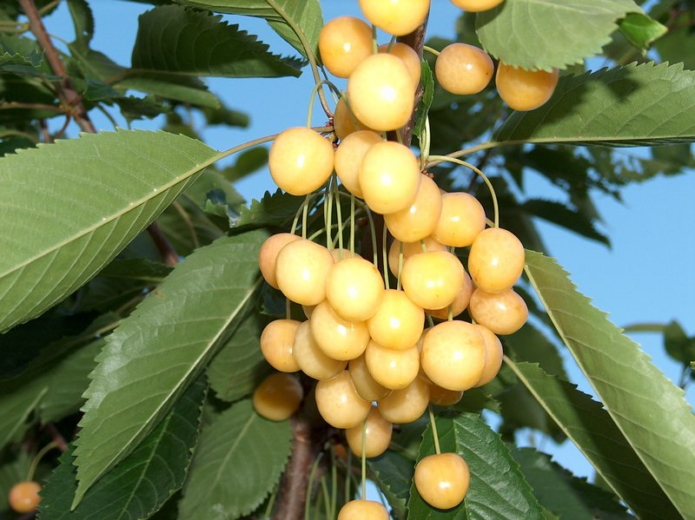
Drogan yellow cherry is suitable for compotes and preserves, but not for freezing; after defrosting, the shape of the berries is not preserved
Drogana yellow fruits ripen by the end of June or July, do not fall off. Trees are productive from 4-5 years old and bear fruit for another 20 years. The yield is stable, up to 30 kg per tree.
The variety is self-fertile, pollinating cherries - Denissena yellow, Gaucher. Hardy and, due to late flowering, does not suffer from recurrent frosts. Approved for cultivation in the Lower Volga and North Caucasus regions, but through the efforts of gardeners, it has successfully expanded the distribution zone.
Drogana yellow tolerates drought well, and in a rainy summer, the skin of the fruit cracks, it is affected by fruit rot. The cherry fly also does not ignore the Drogana berries. However, sweet cherry is not exposed to fungal diseases.
Leningrad yellow
Leningrad yellow - a widespread late-ripening sweet cherry, berries ripen at the end of August. The skin is honey-yellow, the pulp is moderately tart, but sweet and juicy. The fruits weigh 3.4 g.
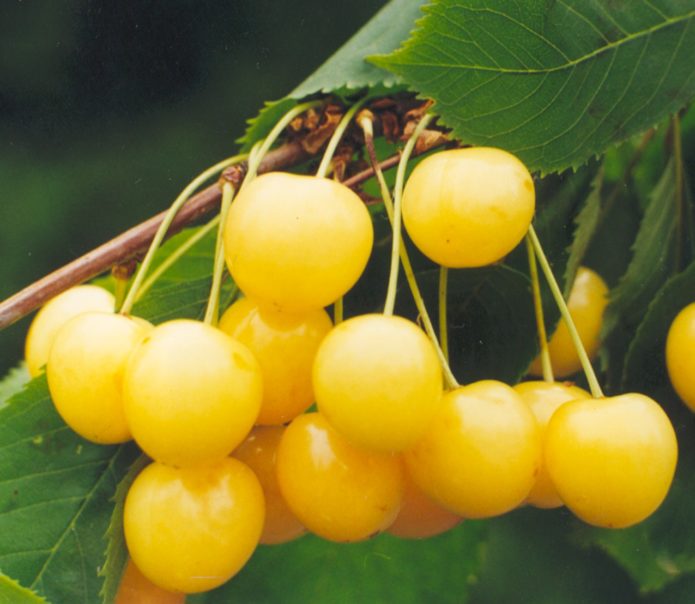
The berries of the Leningrad yellow cherry do not deteriorate, do not lose their taste and appearance within two weeks after picking
On average, it gives 15 kg per tree. Winter hardiness. It is immune to bacterial rot, does not suffer from insect pests, including damage by fruit flies.
Self-infertile. Pollinated by varieties Leningradskaya black or Leningradskaya pink. These three types of cherries were obtained at the Pavlovsk Experimental Station VIR, located near St. Petersburg. Scientists-pomologists of the station have created winter-hardy varieties of sweet cherry, which are successfully cultivated in the North-West region, although they are not formally included in the State Register.
Orlovskaya amber
Oryol Amber - early ripe sweet cherry, berry picking begins in the second half of June. The fruits are intensely yellow with a slight blush, weighing 5.6 g. The pulp is dense, juicy, sweet. Sweet cherries are most often consumed fresh.
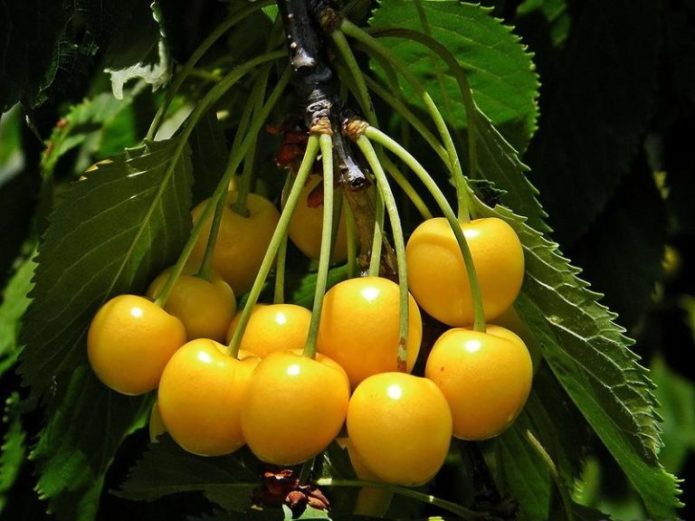
The berries of Orlovskaya amber have a very thin skin that attracts bees, besides, ripe fruits are prone to shedding
From the age of 4, Orlovskaya amber bears fruit, increasing its yield every year. Up to 33–35 kg of berries can be harvested from one mature tree. Needs pollinators, suitable varieties Vityaz, Iput, Gostinets, Severnaya and Ovstuzhenka.
The variety is not included in the State Register. It grows in the Central Chernozem and Middle Volga regions.
Backyard yellow
Household yellow was obtained at the end of the 20th century. Rounded rosy berries weigh an average of 5.5 g. The pulp is pleasantly gristly, sweet, with a slight sourness.
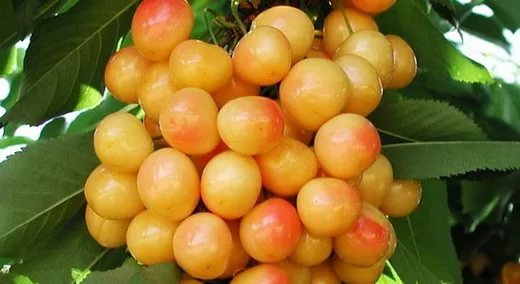
Household yellow is not intended for growing on an industrial scale, since it is poorly stored and transported
It blooms early and gives an early harvest, which begins to be harvested in the second half of June. Regular fruiting from the sixth year without the participation of pollinators. The yield is up to 15 kg per tree.
The advantages of this variety include high frost resistance. Household yellow is zoned in the Central Black Earth Region.
Chermashnaya
Chermashnaya - medium-sized, early-maturing and early-growing cherries. The berries are round, yellow, some develop a blush. Dessert taste, sweet and sour (sweetness is more pronounced, sourness is hardly perceptible). The average fruit weight is up to 4.5 g. The berries are eaten fresh.
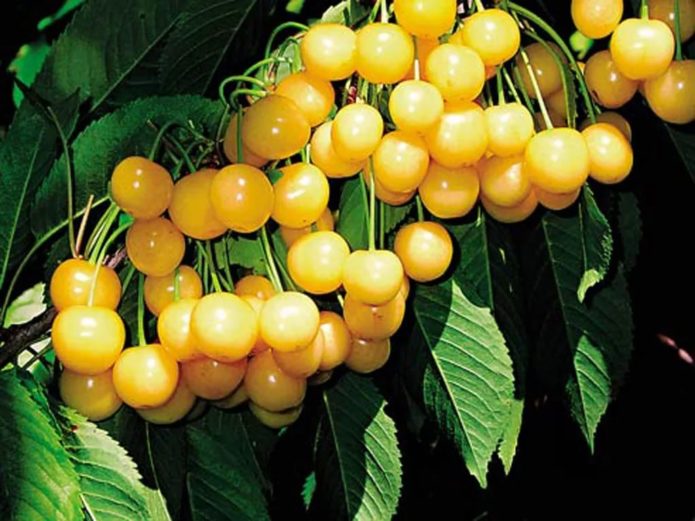
Cherry Chermashnaya is transportable both for short and long distances, the main thing is to harvest in dry weather and pick berries along with tails
The variety is productive, yields up to 30 kg of berries from one tree. When two-year-old seedlings are planted, they are harvested after four years. Self-infertile. The varieties Fatezh, Krymskaya, Bryanskaya rozovaya, Iput, Leningradskaya black or Shokoladnitsa cherry are recommended as pollinators.
Chermashnaya is resistant to fungal diseases of stone fruits. Included in the State Register for the Central Region.
Winter-hardy cherry varieties
In unstable winter weather, when cold weather gives way to periods of thaw, cherry wood is affected, and frost holes appear. And returnable spring frosts are detrimental to the buds, which causes the harvest to suffer. Breeders managed to develop cherry varieties that are resistant to cold in the buds and wood. In addition to the yellow-fruited Leningradskaya and Priusadebnaya, it is worth remembering a few more winter-hardy varieties.
Veda
Veda is a late cherry. Fruits are flattened, heart-shaped, medium-sized. Weight - a little over 5 g. Under the ruby skin lies a juicy, tender pulp. The yield of the variety is up to 25 kg per tree. Fruiting from 4-5 years. The State Register recommends growing in the Central Region.
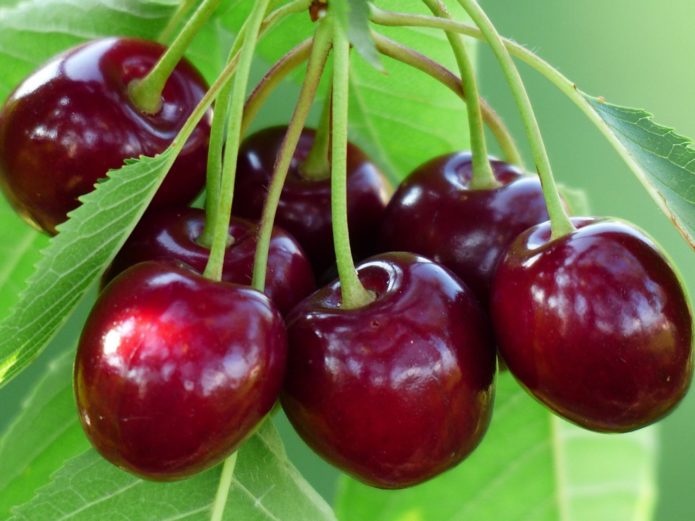
To improve the pollination of any sweet cherry, including the Veda variety, during the flowering period, you can spray the branches with water with honey or sugar, bees will flock to sweets
Bryansk pink
Bryansk pink - very late cherry. The berries are round, coral. Veins shine through the dense skin.Cartilaginous elastic pulp with a rich sweet taste. Fruit weight - 4.5 g. It needs pollinators, the best varieties are Iput, Ovstuzhenka, Revna, Tyutchevka. Average yield - 20 kg per tree. Trees are fast-growing, winter-hardy, not subject to coccomycosis. Sweet cherry Bryansk pink is included in the State Register for the Central Region.
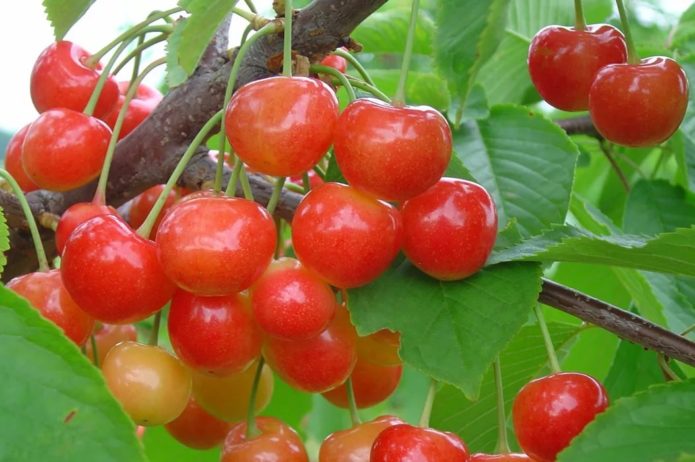
100 g of any sweet cherry, for example, the Bryanskaya pink variety, contains 14-15 mg of vitamin C (the daily norm of an adult is 70-100 mg)
Iput
Iput is a cherry variety with dark pomegranate-colored fruits. Heart berries weigh on average 5 g, although the weight can be up to 10 g. The skin cracks under conditions of excessive moisture. The pulp is dense, dark red, sweet and juicy.
Iput blooms early and gives an early harvest. Fruiting from 4-5 years. The average yield is 20 kg per tree, twice as much in good years. Yields a crop only when adjacent to pollinators. The varieties Revna, Bryanskaya rozovaya, Tyutchevka are suitable for pollination.
Winter hardy, not affected by fungal diseases. Sweet cherry Iput is included in the State Register and approved for cultivation in the Central Black Earth Region.
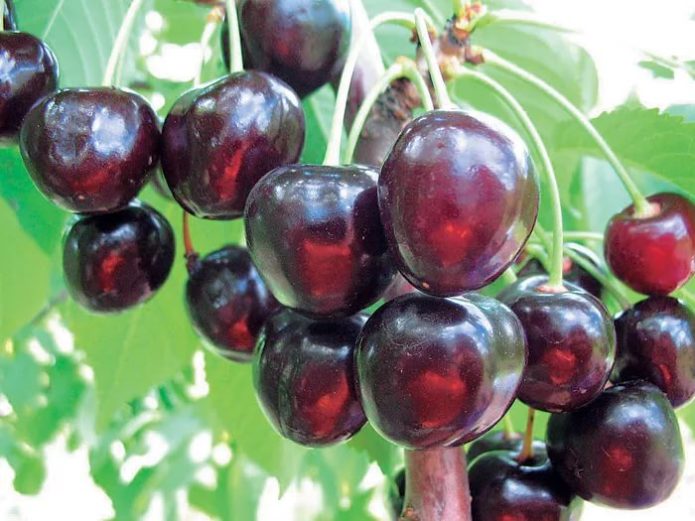
For the Iput cherry, breeders have chosen a name that seems strange to many, and the name was given in honor of the river flowing through the Bryansk region
Odrinka
Odrinka is a late cherry with rounded, dark red berries with a rich taste. The maximum weight of fruits is 7.5 g, weighing on average 5.4 g. Blooms late and yields a medium late harvest. Begins fruiting at the age of 5. Productivity - 25 kg per tree. Self-infertile, the best pollinators are Ovstuzhenka, Rechitsa, Revna. Hardy, not susceptible to fungal diseases. In the State Register for the Central Region.
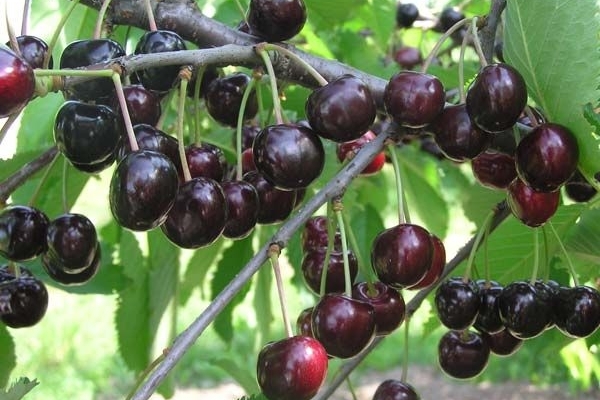
Among other advantages, any cherry, like the Odrinka variety, is very decorative - in the spring it is covered with fragrant flowering, in the summer - with juicy fruits
Jealous
Revna is a medium late cherry. Flattened-rounded fruits weigh no more than 5 g, although some are almost 8 g. The skin is red to black in ripe berries. The pulp is dark, dense, juicy, excellent in taste. Jealousy bears fruit since 5 years. Partially self-fertile, the best pollinators for this cherry are Ovstuzhenka, Tyutchevka, Raditsa, Iput. When adjacent to other varieties, the average yield is 25 kg per tree, and the maximum reaches 30 kg. Shows winter hardiness and resistance to fungal pathology. The variety is included in the State Register for the Central Region.
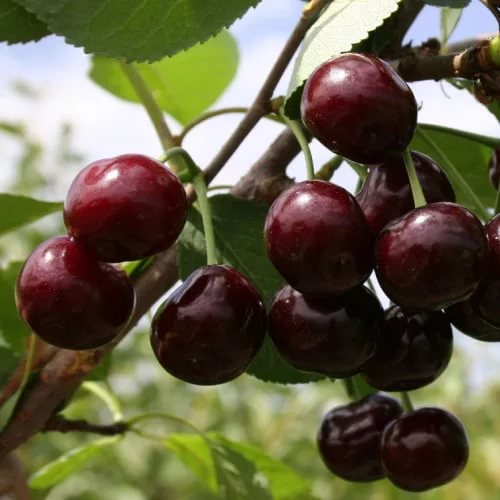
You can keep a fresh crop for six months if you put berries and cherry leaves, for example, the Revna variety, in a clean jar, cover with a lid and put in a cool place
Pink pearl
The berries of winter-hardy cherries Pink pearls are not very large, weigh an average of 5.4 g. In terms of taste, the fruits are pleasant, they are characterized by sweetness. The variety tolerates temperature changes, is drought-resistant and at the same time actively bears fruit. The first harvest appears at 5-6 years, and the first berries - in mid-July. The indicator relative to one mature plant reaches 13-18 kg. The variety is self-fertile and needs pollinators. For these purposes, cherry varieties Michurinka or Michurinskaya late, Adelina, Ovstuzhenka, Plaziya, Rechitsa are used. It is under state test.
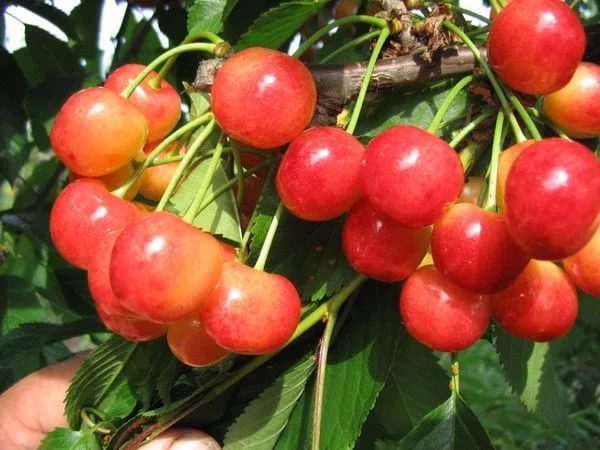
To enhance pollination and attract insects next to any cherry, including the Pink Pearl variety, you can plant melliferous herbs: lemon balm, mint, oregano
Fatezh
Fatezh is a sweet cherry variety. The berries are small, round, medium-early ripening, weigh 4.5 g. The skin is red or red-yellow. The pulp is juicy, has a cartilaginous structure and a pale pink color. The taste is sweet with sourness. The fruits are well transported. The variety is self-fertile, Chermashnaya, Iput, and Bryanskaya rozova are recommended as the best pollinators for it. With the neighborhood of pollinators, it gives up to 35 kg of yield from one tree. Resistant to fungal diseases and frost-resistant. Included in the State Register for the Central Region.
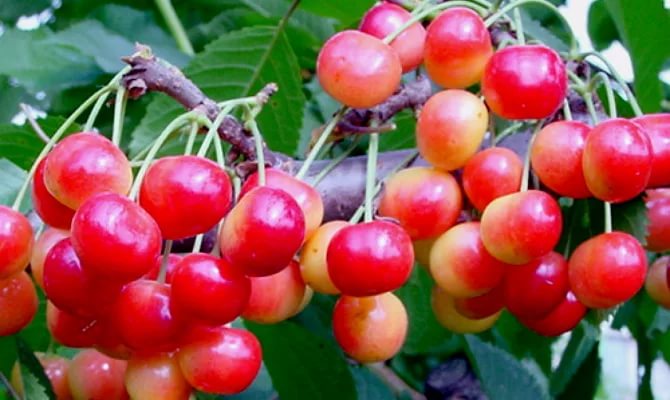
Sweet cherry varieties Fatezh is a recognized pollinator for almost all other sweet cherry varieties, with the exception of undersized ones
Gardeners often increase the winter hardiness of cherries by grafting. In this case, the seedlings retain the characteristics of the selected varieties, while showing resistance to cold and disease due to the hardy rootstock.
Undersized cherry
In small garden plots, tall cherry trees with a spreading crown cause a lot of trouble. Breeders offer varieties with limited growth, easy to care for and harvest. Such cherries are called dwarf or columnar. Fruiting in such trees occurs earlier than in tall cherries, sometimes even in the year of grafting. However, it is recommended to pick flowers of the first year.
In fact, these trees represent an overgrown central conductor 2–3 m high with short skeletal and bouquet branches. To facilitate the maintenance and limit the growth of trees, the formation of a sweet cherry in the form of a bush, in several trunks, is also practiced. Due to the structural features, compact seedlings take up less space on the site, they are planted closer. Columnar trees often need additional support.
Dwarf trees are more demanding than other types of cherries, they need more illumination of the site, the absence of wind and sudden changes in temperature. In addition, they do not tolerate watering flaws and are not drought tolerant.
Seedlings of dwarf trees retain their maternal properties, therefore, not only grafting is used for reproduction, but also planting of seeds. Seedlings generally adapt better to the local climate.
Dwarf trees look advantageous in small areas because of their unusual shape and dense flowering. They are often self-fertile, and their taste is not inferior to large-sized ones. There are not many varieties that can survive harsh winters. Most often, suppliers offer sweet cherries Helena, Sylvia and Little Sylvia, Black Columnar. The variety Sam is proposed as a pollinator, catching up with large trees in height.
Photo gallery: columnar cherry varieties
- Columnar trees can be planted close to each other, at a distance of 1-2 m
- Cherries of the Helena variety can tolerate cold, but it is better to create additional protection for the winter so that it does not die
- Sylvia sweet cherry is a very valuable industrial variety, suitable for transportation and storage under normal conditions for up to 7 days
- Little Sylvia variety retains all its properties for several weeks if stored in the refrigerator
- Pruning low-growing varieties of cherries, like the Black Columnar, is not needed, they themselves stretch up
- Cherry Sam has the highest resistance to fruit cracking among all cherries, therefore it is valued in regions with high rainfall
Sweet cherry with large fruits
As a rule, large-fruited cherries grow in warm regions, are prone to various diseases, and do not tolerate cold and temperature fluctuations. In particular, it is already described above Drogana yellow - its fruits reach 8 g. There are other varieties worth talking about.
It is possible to note the winter-hardy sweet cherry Bull heart, the weight of the berries of which is within 8 g. These dark, sweet berries with a slight acidity have one drawback: with excessive moisture or temperature drops, the peel of the fruit cracks. Due to this, the quality and transportability deteriorate. In the presence of pollinators (varieties Iput, Ovstuzhenka, Tyutchevka) Bovine heart is capable of producing up to 40 kg of berries from one tree. The berries ripen by the end of June. It is grown mainly in the southern Black Earth region.
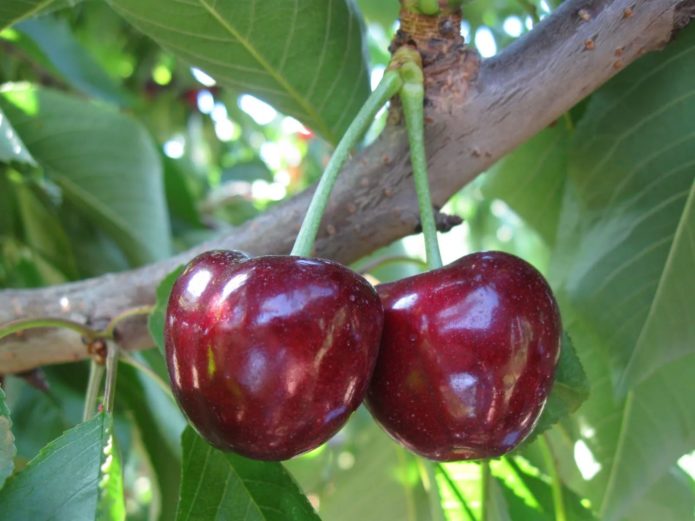
Berries sweet cherries Bull heart gives one of the largest among all varieties, but they do not tolerate transportation well and immediately burst (since the pulp is very juicy)
Some gardeners cut off up to a third of the flowers to increase the size of the fruit, artificially reducing the number of ovaries. In this case, the remaining berries receive more nutrition and develop better.
Self-fertile varieties of cherries
Due to the peculiarities of the structure of the flower, sweet cherry is mainly a cross-pollinated plant. Most varieties of cherries are self-fertile, however, self-pollinated cherries also exist.
The berries of the Narodnaya Syubarova sweet cherry reach a weight of 5–7 g. This is an example of an unpretentious sweet cherry growing on any soil and in almost any climate. Despite the cold snowy winters and strong winds, bright scarlet berries ripen on cherries in the second half of July. Up to 40-50 kg of harvest is harvested from a tree without the presence of other varieties. Not included in the State Register. It is widespread in the Crimea and the Volgograd region, but gardeners manage to expand the cultivation area of Narodnaya Syubarova due to the unpretentiousness and winter hardiness of the variety.
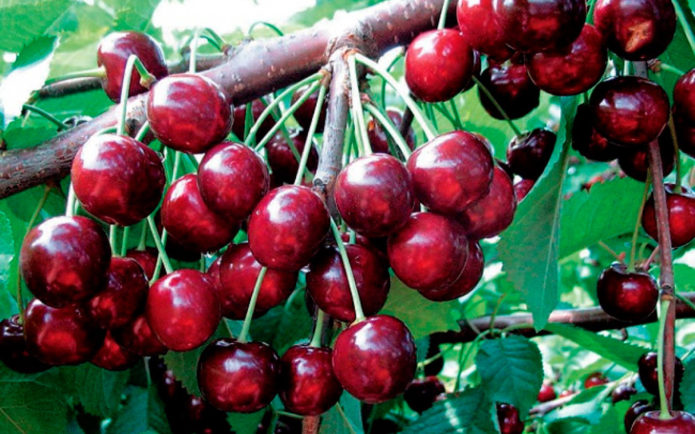
Self-fertile Cherry Narodnaya Syubarova, like other self-fertile crops, in the presence of pollinators will bear more fruits
Partly self-fertile varieties include early middle Ovstuzhenka, the average weight of which is 4 g. Berries are dark cherry in color, medium-sized, slightly elongated, with dark sweet pulp. Without pollinating trees, only 10% of flowers form berries. The best neighbors are Iput, Raditsa, Bryanskaya rozovaya. Yielding variety (up to 20 kg per tree). The oatmeal is not affected by coccomycosis and is resistant to cold, transferring without damage to frost up to -40aboutC. In the State Register for the Central Region.
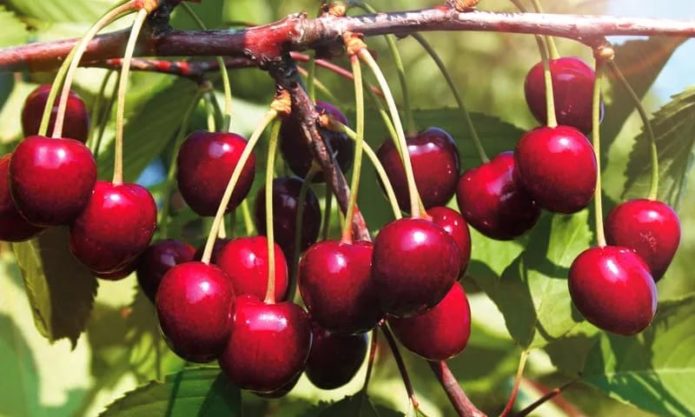
Cherry Ovstuzhenka does not like weeds very much, you need to weed the trunk circle in a timely manner, increasing it by 50 cm annually
There are other partially self-fertile varieties, for example, Revna, but it also bears fruit better in the presence of pollinators. Without proximity to other varieties, 5–10% of flowers are tied.
Early cherry
Sweet cherry begins to bear fruit at 5-6 years. Cherries Iput, Veda bear fruit from 4-5 years. The four-year-olds of Orlovskaya Amber and Chermashnaya are not inferior to Adeline in terms of yield. But there are also champions.
There is a sweet cherry that yields a harvest already in the third year after planting. This is the Orlovskaya pink variety, the flattened-rounded berries of which are even, with an average weight of 3.5 g. The skin and pulp are pink. The taste is sweet with a gentle sourness. The yield of the variety is 20 kg per tree. Self-infertile, pollinating varieties - Vityaz, Iput, Gostinets, Severnaya and Ovstuzhenka. Its dignity is in resistance to fungal diseases and early maturity. Approved by the State Register for cultivation in the Central Black Earth Region.
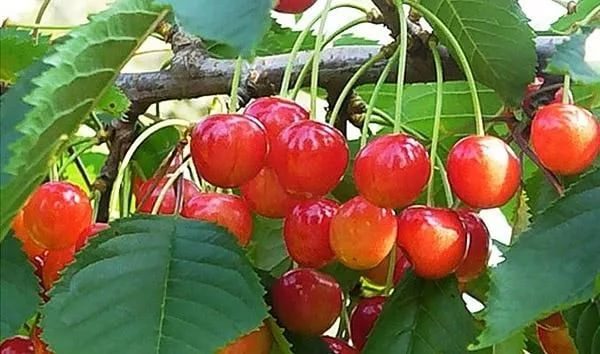
The sweet cherry variety Orlovskaya pink surpasses all varieties in frost resistance: after being tested by a severe frost, the tree continued to bear fruit
Adeline lags slightly behind Orlovskaya rosea, giving the first harvest in 4 years. The variety is mid-season. The heart-shaped berries are ruby-colored. The average weight of Adeline's fruits is within 5.5 g. The pulp is juicy, cartilaginous in structure. Due to the dense consistency of the pulp, the fruits are perfectly transportable. Self-infertile variety, the best neighbors will be Poetzia and Rechitsa varieties. The yield is low, a little more than 20 kg per tree. Included in the State Register for the Central Black Earth Region.
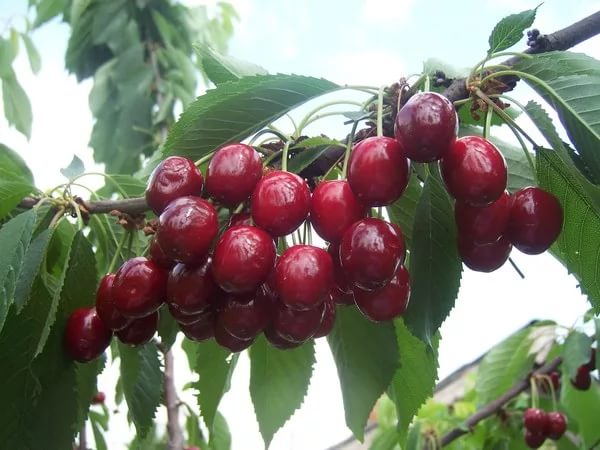
If you want to protect the entire and so small crop of Adelina cherries from birds, then the nets that cover the trees can help
Sweet varieties of cherries
The sweetest cherries for the middle band:
- Adeline;
- Bryansk pink;
- Iput;
- Jealous;
- Ovstuzhenka;
- Chermashnaya.
In addition to these varieties, it is worth mentioning the mid-ripening cherry Tyutchevka, whose fruits are dark red, juicy, dense, weighing 5.3 g. Needs pollinators, recommend varieties Bryanskaya rozovaya, Iput, Ovstuzhenka, Raditsa, Revna. In a typical year, 25 kg are harvested from a tree. Excellent cold-resistant and disease-resistant sweet cherry. Included in the State Register for the Central Region.
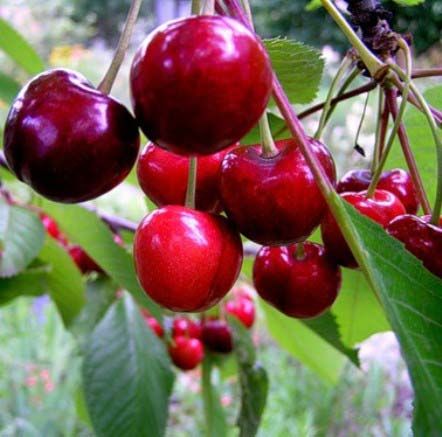
Cherry varieties Tyutchevka Sweet cherry has good resistance to many diseases, but can be affected by coccomycosis and clotterosporium
Features of planting and growing cherries in central Russia
When planting cherries, it is necessary to take into account the climatic characteristics of the region, the composition and level of acidity of the soil, as well as the varietal characteristics of the sweet cherry itself.According to IV Michurin, the variety ensures the success of the business.
Sweet cherry prefers to grow in warm, lighted areas, protected from piercing winds. It does not tolerate stagnant water and acidic soils, therefore, before planting trees, the soils are deacidified, introducing 3-5 kg of dolomite flour into the planting pit for these purposes. All stone fruits love light soils, so sand is added to the soil mixture to improve its composition (in proportion to dolomite flour), and crushed limestone is poured onto the bottom of the pit to improve drainage and provide cherries with calcium.
The seedlings are purchased from reliable suppliers or from large nurseries. Check the condition of the kidneys and root system. The buds should be awake and the root system developed and completely cover the container.
It is preferable to purchase containerized cherry seedlings, since the closed root system is not injured during transportation and is less stressed during planting.
Prepare a place on the site in advance. The projection area of the crown corresponds to the prevalence of roots, therefore, more space is left for higher varieties. In addition, the need for pollinators is considered. Planting holes are dug at a distance of 3-4 meters from each other. To plant one seedling:
- Dig a hole 80 cm in diameter and up to 70 cm deep.
- The top fertile layer is separated.
- Crushed stone is poured onto the bottom for drainage.
- Dolomite flour and sand (1: 1) are mixed with their own fertile soil layer, adding organic matter (humus, compost or peat in equal quantities), and poured back.
- The planting stake is fixed and the seedling is placed next to it so that the root collar rises above the soil level.
- A tree is tied to a peg.
- Compact the soil around the seedling, forming an irrigation hole.
- Water abundantly (up to 3-4 liters of water).
- To reduce moisture evaporation, cover the trunk circle with mulch.
Sweet cherries are characterized by intensive growth, therefore, it is advisable to immediately cut off the central conductor to a height of 50-60 cm in order to form a longline crown in the future. If the skeletal branches are already formed, then they are pruned so that they are shorter than the trunk.
When planting, organic fertilizers are applied so that the soil under the trees is not fertilized in the next few years. Further watering of seedlings is carried out if necessary. Excessive soil moisture leads to decay of the roots, and during the period of fruit ripening - to their cracking. Important periods for watering cherries are the time of flowering and formation of the ovary, immediately after harvest and a month before the expected constant cold weather (early or mid-October). The rest of the time, cherries are watered based on the characteristics of the climate.
Video: planting cherries
It is recommended in early spring to prophylactically treat cherry seedlings with a 1% solution of copper sulfate or Bordeaux liquid to prevent fungal diseases. If necessary, repeat the procedure before flowering.
Regular pruning is done in early spring in order to remove damaged branches and form the crown correctly. Weak, thickening, criss-crossing branches are removed, thereby indirectly regulating flowering and providing a crop.
In autumn, it is recommended to whitewash not only the trunks, but also the main skeletal shoots to protect the bark from frost damage. In the early years, it is recommended to cover the seedlings before the winter cold by wrapping the trunks with corrugated cardboard or other material in order to protect the planting from rodents.
Reviews
Advantages: large, dense berries, a powerful tree, high resistance to fungal diseases. Disadvantages: unripe bitter, ripened at the same time as cherries. The strange name did not bother me (I chose the seedling myself) I chose the variety according to the description - I don't even remember how it attracted me, but for some reason I chose it. For three years I had to wait for the harvest, or even all four ... Surely, I looked so that it did not freeze and hurt a little, pollinated well and tasted good.As for fruiting, it is difficult to judge by the first year, but there is something to try, despite the fact that the children ate it even before ripening. It seems to have started well enough. Her berries are large, glossy, dark red. Simultaneously with the cherries, they became edible, in my opinion, they were ripe. In the description of the Iput cherry variety, it is indicated that the berries should be dark red, almost black - but how long to wait until they become like that? I would not say that this is an early variety, compared to the rest of our cherries - this is a rather late ripening. I bought a seedling of this cherry directly from the nursery, in theory they should not have been confused - all the other seedlings coincided in varieties. The berries of this cherry have a very dense flesh, but there is enough juiciness. The juice is dark red.
Maybe because of their density, or because we somehow tried to save them from being eaten by birds using a special net, but the sparrows ignored them, unlike other cherries, earlier and also red (I am not I know), and our cherry got a good deal from them. Or maybe the whole point is that due to the abundant amount of foliage, cherry berries are not so noticeable from above? In any case, let's hope that birds will love this little sweet cherry less, and for this it will be possible to forgive her so late ripening - in the 20th of June, it turns out. The pulp of the berries adheres well to the stone. The stone is very small, oval and smooth, the pulp gives off normally. Several berries have cracked, but now it is very rainy, and the cracks with sweet juice fell in love with the ants, which we have a lot of darkness ... It seemed to me that the Iput cherry is quite resistant to diseases, at least visually looks much better than many of our other fruit trees ... The foliage is fresh and green, although the tree is young, but powerful. Aphids are not severely damaged. I recommend)
A friend has five cherries at his dacha, planted quite tightly (2.5–3 meters apart) and small, with my 7-meter ones. All fruit successfully. In the winter of 2010–2011, some of his cherries froze over, but I don't. Probably depends on the variety, although mine are tastier. If you buy cherries now, then all the trees are grafted onto dwarf or semi-dwarf rootstocks. They certainly won't be big. But it is better not to plant one tree - at least three, of different varieties, otherwise you will never get a harvest. In central Russia, cherries will be constantly freezing. Minus 30 is the limit for her, even for several hours. I also want to add from my own experience. Some cherry varieties have one property. After a certain age, they stop giving growth (tops). It seems to be convenient - you don't have to bother and clean up the tree every year, but it also means that if you accidentally lose a branch, then a branch on this tree will not grow anymore. Including, with pruning, in adult cherries you need to be more careful.
I have 2 cherries growing: Fatezh and Iput. Fatezh is already 6 years old, Iput - 4 years. Both bear fruit. This year, Fatezh was generally sprinkled, and this despite the fact that when it bloomed, there were frosts! During this time, the winters were different, the cherries did not freeze. But Fatezh is very susceptible to gum flow (perhaps it's just me). And every year it harms the tree more and more: '(
In my garden there is a native-rooted sweet cherry of the Bryansk pink variety, I planted cuttings on the Vladimirka cherry growth 4 years ago, the next year I removed a strip of bark from the shoots from below and covered it with earth, the next spring I carefully cleared the embankment and cut off the seedlings from the rootstock. Two winters wintered well, the growths are long, there were single flowers, but there is one drawback - a superficial root system, a stable support is needed, otherwise the tree falls.
In search of new experiences, we often do not notice how much miraculous is happening before our eyes.After all, the fact that the thermophilic cherry has spread far to the north and adorns summer cottages even in the North-West region can only be called a miracle.
